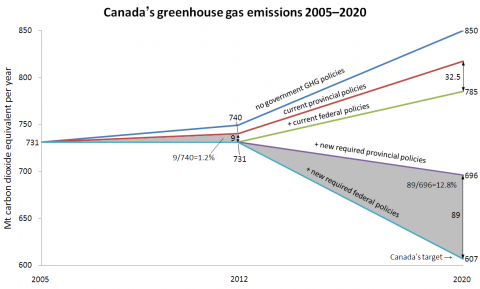The Harper government will have to start trying 10 times harder to cut Canada's greenhouse gas emissions if it wants to meet the target it's committed to in international climate negotiations. This is revealed by two new reports that Environment Canada recently posted on its website.
In the first report, which appeared in early June, Environment Canada states that it expects federal policies to reduce annual greenhouse gas emissions by nine million tonnes (Mt) in 2012, relative to where they would be without those policies. This is a reduction of just 1.2 per cent in Canada's 2012 emissions relative to the no-policy scenario.
The second report appeared on Environment Canada's website just before the August long weekend. It contains a detailed projection of what will happen to Canada's greenhouse gas emissions over the next decade in the absence of new government policies. This is important information that outside analysts need in order to understand the effectiveness of policy proposals. Its publication now is particularly welcome because although Environment Canada updates these projections annually, the last time it published one was over three years ago.
Environment Canada's new projection shows that in the absence of any government policies to curtail emissions, and with mid-range assumptions about economic growth and the price of oil, Canada's annual greenhouse gas emissions would reach 850 Mt in 2020, compared to 731 Mt in 2005.
Hitting the target
Taking into account federal policies "implemented or announced in detail as of November 2010" and provincial policies "announced and fully implemented as of March 31, 2010," the second Environment Canada report projects Canada's 2020 emissions to be 785 Mt, with the federal and provincial levels contributing "in roughly equal measure." But our national emissions target is much lower than that projection: the Harper government has committed to reduce Canada's emissions in 2020 to 607 Mt (17 per cent below the 2005 level).
Using the key numbers from the two Environment Canada reports, Figure 1 (below) depicts Canada's greenhouse gas emissions between 2005 and 2020 under three scenarios:
- with no government greenhouse gas policies (business-as-usual)
- with current policies (as defined above)
- with new policies required to meet Canada's 2020 target.
The figure assumes that federal and provincial levels of government would continue to share the effort equally. It also simplifies reality by not depicting the year-to-year fluctuations in emissions caused by events like the recent recession, but this does not affect our conclusions.
The left-hand shaded area in Figure 1 shows that during the Harper government's first seven years in office (2006-2012 inclusive), its efforts will — as noted above — have reduced Canada's annual emissions by 9 Mt or 1.2 per cent, equivalent to 0.17 per cent per year. The right-hand shaded area in the figure shows that during the subsequent eight years (2013-2020 inclusive), federal policies would have to reduce annual emissions by 89 Mt, or 12.8 per cent, in order to meet Canada's 2020 target. This is equivalent to 1.7 per cent per year, a tenfold increase in policy effectiveness.
Ramping up the effort
It could be argued that federal emission emission-reduction efforts only need to be increased fourfold, because the 32.5 Mt impact of current federal policies in 2020 needs to be increased to 32.5+89=121.5 Mt to meet Canada's target (see the numbers at the right-hand side of Figure 1). But to make a fair comparison of the effort entailed in two sets of policies, you have to compare their impact on emissions over similar time periods. This is because policies generally have a bigger impact on emissions over a longer time period, without any extra effort by government (the key government effort is at the beginning, getting the policies adopted and implemented).
To believe the government intends to meet its target, you have to believe it's suddenly going to start working 10 times harder.The fourfold calculation would also exaggerate the scale of current federal policies because some measures included in that category have not yet been implemented. For example, emission limits on coal-fired electricity have been announced, but they won't be reality until regulations have been drafted, finalized and approved by cabinet. (Additional "current" policies will probably be announced before the end of 2012 but they are unlikely to have a significant effect on emissions until later.)
While the amount of emission reductions is not a perfect way to compare policy effort, it's the most objective method we have. Doing the comparison fairly, over similar time periods — i.e., comparing the two shaded areas in Figure 1 — shows that the federal effort needs to increase tenfold by the end of next year.
In other words, to believe the government intends to meet its target, you have to believe it's suddenly going to start working 10 times harder.
Sadly, the idea that there is about to be a tenfold ramp-up in federal efforts to cut greenhouse gases would make just about any observer of this file laugh in disbelief. Prime Minister Harper's lack of enthusiasm for the issue is well known, and that's unlikely to change after an election campaign in which he dismissed the single most important climate policy tool — carbon pricing. Environment Minister Peter Kent speaks of a gradual process of introducing emissions regulations one sector at a time. Most federal spending programs to address greenhouse gases expired in March this year.
Where there are new federal climate policy announcements, the test that we should be applying to them is: do they credibly contribute to a tenfold increase in overall ambition?
But in the absence of any sign that the federal government is about to start trying 10 times harder, I think that whenever the Government of Canada refers to its greenhouse gas target, Canadians and foreign governments are fully justified in questioning whether our government has any intention of meeting it.






